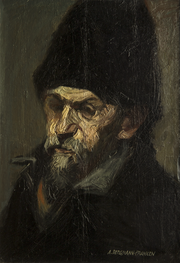International and Interdisciplinary Conference: Cultures of Solitude

July 30-31, 2015
University of Würzburg, Germany
The withdrawal from society is an international and transhistorical, yet also culturally specific phenomenon. This international and interdisciplinary conference seeks to explore American cultures of solitude and their representations in cultural products from the colonial era to the present time. Representations of hermits and recluses – whether fictional or historical, deliberately seeking or forced into isolation, temporarily or finally withdrawing from society –, abound in American cultural history. Media depicting hermits and recluses range widely in time, from the seventeenth to the twenty-first century, and in genre, from broadsides to novels, from poems to plays, from songs to musicals, from ballet to opera, from engravings to art installations, from documentaries to TV shows, and from computer games to social media.
While habitually perceived as exile or enclosure, reclusiveness and hermitism often manifest themselves as a form of liberation, independent of the topographies of isolation, the politics of solitude, and the culture of privacy involved. Indeed, the element of liberation can be traced back to the very origins of the term 'recluse.' In classical Latin, recludere denoted 'to un-close', 'to disclose,' or even 'to reveal.' Although in late Latin it came to mean 'to shut off' it retained its active charge: a believer opted for seclusion, thus freeing himself or herself from a restrictive environment. Independence and liberty are venerable American ideals. Freedom was the initial motivation for many early settlers to come to the New World. Later, individualism and freedom became the key to the westward movement and the underlying features of the frontier spirit. Over the course of American history, freedom was sought in numerous manifestations such as religious freedom, economic independence, political autonomy, female emancipation, abolition of slavery, and the absence of social restrictions, among many others. Approached in this way, hermitism and reclusiveness can be understood as extreme manifestations of liberation and individualism, which became a significant, if not the second most important American motif, besides the theme of the settlement, colonization and reclamation of the New World.
On the one hand, there are depictions of hermits who find freedom in living alone in the wilderness. They spend their lives isolated in nature. On the other hand, there are portraits of urban recluses who live outside society without spatially retreating from the city. They withdraw into the privacy of their room or house. Both types of solitaries are secularized versions of early religious solitaries. The original hermits were the Desert Fathers. The European anchorites of the Middle Ages, who followed their example, were their earliest urban equivalents. Thus, these two solitary ways of life have a common origin and they also seem to have a common motivation, the quest or urge for freedom. At the same time, hermitism and reclusiveness also entail confinement and limitation. The liberating effects are often the result of an initial situation of withdrawal without alternative. And even if the retreat is willfully sought, it goes hand in hand with deprivations of all kinds. This may be more obvious with regard to urban recluses, as in their case the confinement, the limitation of space, is most obvious, but it also applies to hermits in nature. Asceticism and frugality are, for example, physical limitations that often flank hermitism in nature. Yet, solitary ways of life seem to be more liberating than limiting in numerous ways.
In the larger social context, hermits and recluses in the New World on the one hand parade typically American values such as independence and self-reliance, liberty and privacy. On the other hand, their withdrawal runs counter to equally prominent and venerable American merits such as community, sociability, and the social compact. These conflicting issues do have a long tradition in the American mindset, originating, respectively, in the colonial and the constitutional era, but never have they been more relevant than in the present time. Depending on the chosen perspective, hermits and recluses can be read as trailblazers for an alternative future or as symptoms of a pathological society.
The topicality of this subject matter further derives from the concepts and issues that inform and flank the withdrawal from society, such as the topographies of isolation, the politics of solitude, the cultures of privacy and home, the artistic and creative potentials of reclusiveness, the spiritual promises of exile, the mental and physical conditions of retreat, the social preconditions of withdrawal as well as the function of shifting representations of solitude. A number of recent and also more established disciplinary and interdisciplinary trends in American Studies such as Ecocriticism, the Spatial Turn, Body Studies, Gender Studies, Studies of Illness and Age, Life Writing as well as Intermediality Studies provide a broad theoretical foundation for the exploration of cultural representations of both, urban recluses and hermits in nature. At the same time, Hermit Studies can enrich and enhance the insights of these fields of research in many ways. This symposium on the cultural history of American hermits and recluses aims to reveal this relevance. An array of distinguished European and American scholars from a wide range of subdisciplines of American Studies such as Literary Studies, Cultural Studies, Media Studies, Political Studies, History, and Art History will explore representations of retreat and withdrawal in American Culture and thereby investigate the liberating and limiting aspects of American cultures of solitude.
Contact: solitude@uni-wuerzburg.de
Organizer: PD Dr. Ina Bergmann
Associate Professor, American Studies, University of Würzburg, Germany
Assistant Organizer: Stefan Hippler, M. A.
Assistant Professor, American Studies, University of Würzburg, Germany
The conference in EinBLICK.
Find us on facebook.
Artwork: Alois Bergmann-Franken, "Der alte Loy" [Old Man Loy], oil on canvas, c. 1921-27


